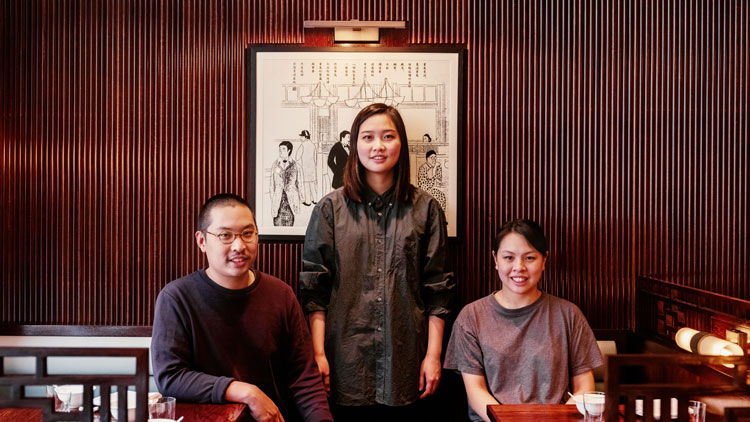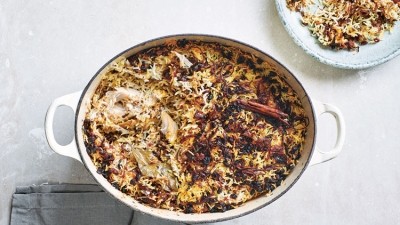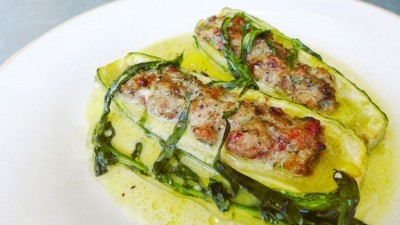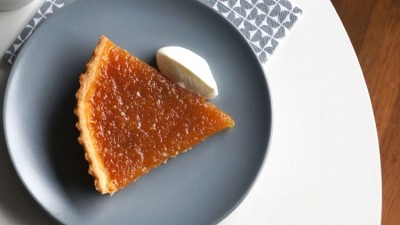Chef Masterclass: char siu pork by Xu's Erchen Chang
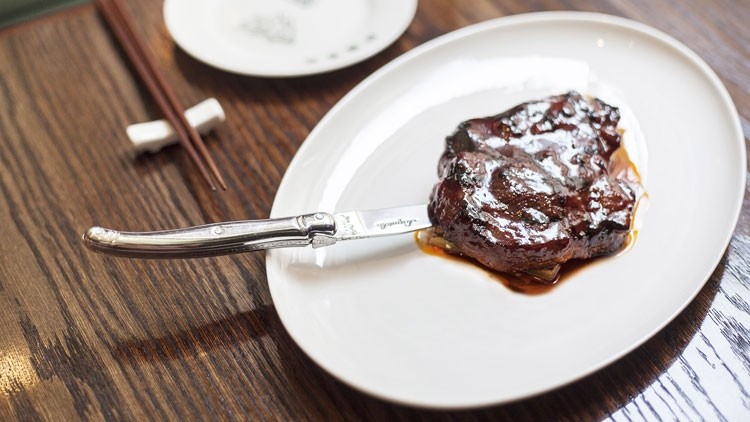
Whole ducks lacquered and roasted to a deep shade of chestnut brown. Slabs of fatty, crisp-skinned belly pork. Chickens marinated in salt and steamed with ginger. And char siu pork – traditionally the fillet, marinated with sugar, salt, bean curd and various sauces and pastes, then roasted or barbecued, burnished to a deep red and lusciously sticky.
At Xu, the highly-acclaimed Taiwanese restaurant on Rupert Street, chef and co-proprietor Erchen Chang prefers to use pork neck, rather than the much leaner fillet, “because the fat tastes so good”. “We use Ibérico pork, which is tender, with dark meat and lots of marbling.” The marinade is high in both salt and sugar, so it partially cures the meat, as well as flavouring it.
Char siu literally means fork-roast, referring to the traditional technique of roasting strips of marinated meat on long forks over a fire, but it is a term that has come to refer almost exclusively to cuts of pork, and is popular all over the Far East, and in Chinatowns the world over. “In Taiwan, char siu is quite traditional, mainly using the fillet, but the younger generation prefer fattier cuts,” Chang explains. Hanging the meat for a day or two after roasting lets it absorb more of the marinade, making the outside even stickier. Its deep-red colour usually comes from red food colouring; Chang prefers the more natural beetroot powder.
There are, of course, as many recipes for char siu as there are cooks. Some marinades include ginger, others use star anise or five-spice powder, while hoi sin or oyster sauce are also common additions. Chang’s recipe came from a Hong Kong friend.
“So this is a Cantonese recipe. You can find all the ingredients for the marinade in Chinatown or online. To get a true complexity of flavour, we use three kinds of fermented soy beans and bean curd: white miso, which gives a light fragrance; white or red bean curd, for the mid-tones; and yellow bean paste, which has a deep, rich flavour.”
Chang talks about flavour rather as a painter might discuss colour – appropriately, since she studied fine art at the Slade School in London. There, she met fellow student Shing Tat Chung, who is now her husband and business partner in both Bao, their hugely popular street food restaurants, and the year-old Xu (along with his older sister, Wai Ting, and Karam Sethi’s JKS restaurant group).
After being marinated, the pork can be cooked in several ways: on a barbecue, in the oven, or on a griddle pan. Chang uses the Josper in her kitchen at Xu. “It’s at a much higher temperature, so there’s a lot of taking the meat in and out of the oven, checking if the meat is cooked through. The charcoal flavour definitely adds depth to this dish.”
Sweet, richly-flavoured char siu is traditionally offset with plain rice and greens - pak choi, perhaps, or gai lan (Chinese broccoli) – while Chang serves it with cucumber, seared on a grill until almost black, then scattered with sesame seeds and doused in a dressing of Szechuan chilli oil and black rice vinegar.
“I love how the tender, fatty char siu pork neck works so well with the juicy cucumber and a bit of a kick from the chilli oil,” she says.
Should you have leftovers, char siu pork is immensely versatile. “In Taiwan,” says Chang, “we often have cold meat as a starter: slices of chicken, goose and char siu, maybe. Or you can put a few slices on top of a bowl of noodles.”
As co-owner of Bao, she has one more suggestion. “You can definitely put it in a bun!”
Char siu pork with seared cucumber
Makes twelve 160g portions
Ingredients
For the marinade
30g onion, peeled and coarsely chopped
30g garlic, peeled and coarselychopped
15g shallot, peeled and coarsely chopped
175g caster sugar
40g salt
30ml Mei Kuei Lu Chiew (Chinese rose-flavoured liqueur: look for the Golden Star brand)
15g Chinese sesame paste
15g white miso paste
15g yellow bean paste
15g white or red fermented bean curd
15g light soy sauce
15g dark soy sauce
50g beetroot powder
2kg boneless pork neck, trimmed
To serve
2 cucumbers
8 tbsp white sesame seeds, lightly toasted
8 tbsp Szechuan chilli oil
4 tbsp black rice vinegar
Method
1. Blitz together the onion, garlic and shallot until smooth, then mix thoroughly with the remaining ingredients, except the beetroot powder.
2. Slice the pork neck across the grain into 1.5cm-thick steaks. In a non-reactive bowl or a zip-lock bag, mix the pork steaks in the marinade, refrigerate and leave for at least 12 hours.
3. Heat an oven (250°C), charcoal grill or a grill pan until very hot. Remove the steaks, then whisk the beetroot powder into the marinade. Brush the pork steaks with more of the marinade.
4. Cook the pork steaks until they begin to char on the outside and are cooked through (65oC internal temperature), brushing with more of the marinade once or twice during the cooking process. Remove the steaks from the heat, then paint with more marinade and leave to rest.
5. While the pork rests, peel the cucumber and trim it into rectangles about 5cm long and 1cm thick. Sear them on both sides on a very hot grill, or in a non-stick frying pan, until dark brown and juicy. Remove from the grill.
6. To serve, arrange four pieces of seared cucumber on each plate. Sprinkle with 2 tsp of sesame seeds, and drizzle with 2 tsp of Szechuan chilli oil and 1 tsp of black rice vinegar. Place one grilled pork steak on top, and serve with rice.
